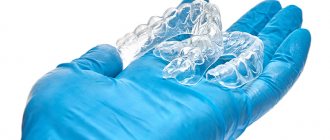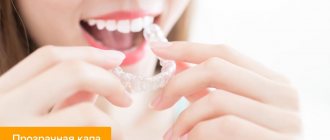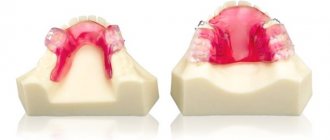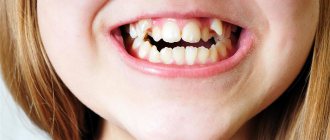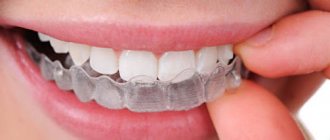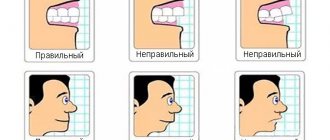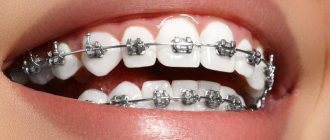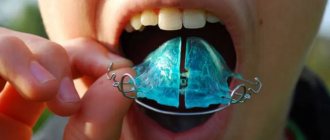Sports mouth guards
A sports lifestyle is becoming more and more popular, and at the same time the number of maxillofacial injuries received during sports is increasing. First of all, the front teeth of the upper jaw are injured; malocclusion in an athlete increases the risk of damage to the dentition.
The most traumatic sports for teeth are hockey, American football, rugby, skating, boxing, kickboxing, but damage to the dentition can occur during any sports activities where contact with a hard surface or other athletes is possible. Professional athletes are required to wear mouthguards; it is recommended that amateur athletes also use this simple but effective means of protection.
Purpose of sports mouthguards, types
What does a mouthguard give an athlete:
- Eliminates the possibility of teeth biting soft tissues at the moment of impact;
- Absorbs and distributes impact energy, thereby reducing the risk of damage to teeth, jaw bones and cervical vertebrae;
- Prevents occlusal contact and injury to opposing teeth during impact;
- Reduces the risk of concussion and the development of neurological disorders;
- Gives the athlete a feeling of confidence in his safety, so during competitions he focuses only on the game;
- Specially made mouthguards increase the strength, endurance and reaction speed of athletes.
Mouth guards can be one-sided (put on one jaw) or two-sided. Also, protective devices are divided into the following groups:
- Standard – sold in sports stores ready-made in several sizes. The disadvantage of such mouthguards is poor fixation on the teeth, lack of individual adjustment to the dentition, low degree of protection;
- Thermoplastic – also sold ready-made, but differ from standard mouthguards in the ability to be adjusted. The material of manufacture is thermoplastic; to adapt to the dentition, the mouth guard is preheated in hot water. They are more comfortable to wear compared to standard ones, but also a little more expensive;
- Individual - made for each athlete according to personal models based on dental casts. It is possible to manufacture mouthguards for teeth with braces, which is important for young athletes, since it is during adolescence that braces are most often installed.
Types of mouthguards for bite alignment
Aligners for bite correction have their own classification. They are classified into different types according to production technology, wearing time and manufacturer. Below we will look at the different types of mouth guards and give a brief description of their unique characteristics. According to production technology, mouthguards are divided into two types: thermoplastic and individual.
Thermoplastic mouthguards
An attractive budget option.
How effective will thermoplastic aligners be in straightening the bite? Only an orthodontist can answer this question after an examination and diagnostic measures. The peculiarity of this type of mouthguard is the unique properties of the material used to make them: at certain temperatures, it becomes soft and elastic, due to which it fits tightly to the dental surfaces and ideally follows the natural shape of the teeth. When making a mouth guard, thermoplastic is applied to the patient’s teeth and an impression is taken, which is further modified as necessary. The entire process is carried out in the patient's mouth. The patient wears the finished mouthguard in accordance with the orthodontist's recommendations.
Custom mouth guards
Individual mouthguards have a fundamentally different production technology. The patient comes to the specialist’s office, and the doctor takes an impression of his teeth. The impression is transferred to a specialized laboratory, where, using computer technology, individual attachments for the entire course of treatment will be made. Individual mouth guards are more comfortable to wear, the process of adaptation to them is faster, and, accordingly, their price is higher than that of thermoplastic structures.
Types of aligners by wearing time
Depending on the time of wearing, there are two types of mouth guards – round-the-clock and night.
24-hour products are used to correct bites and are worn without removal almost 24 hours a day. It is allowed to remove the mouthguards for no more than two hours to carry out hygiene procedures and rinse and clean the structure itself. If this rule is violated, the effectiveness of the correction decreases and the overall treatment time with mouth guards increases. Night guards are used to consolidate the achieved positive result.
The attachments are put on overnight and can be used both after treatment with 24-hour orthodontic mouth guards and after a course of correction with braces.
Mouthguards from different manufacturers
The characteristics and quality of aligners differ from different manufacturers. The choice of manufacturer brand is carried out jointly with the doctor, based on the characteristics of the clinical case, the patient’s preferences and his financial capabilities. Let's take a brief look at the features of mouth guards from the most popular manufacturers.
OrthoSnap
A well-known American brand that supplies the dental market with mouthguards of the highest level of quality. The brand's products are made from materials that are biocompatible with the tissues of the human body, do not cause discomfort during everyday use, and are aesthetically pleasing and invisible in the oral cavity.
Invisalign
One of the most famous and popular brands producing orthodontic aligners. A unique feature of the attachments is the fixation method, which allows to reduce the overall treatment time. The use of Invisalign aligners allows you to achieve a positive correction result in an average of 1.5 years of constant wearing of the structure. About 30 sets of caps are produced for a course of treatment.
ClearCorrect
The course of correction with mouth guards from this manufacturer can last up to two years. The products are used primarily for the treatment of minor malocclusion defects. About twelve replacement sets are produced for the course. The brand's mouthguards are valued for their low risk of allergic reactions and high level of wearing comfort.
General presentation and purpose
The starting point for the use of such structures is the last decade of the century before last, but mass distribution began only towards the middle of the twentieth century. Formally, the inventor of mouthguards in the form in which we know them today is considered to be the American dentist Rodney Liliquist - he was the first to describe in detail the technology for making a protective lining from acrylic.
A sports mouthguard for boxing is a product made of elastic material, worn over the upper dentition, the main function of which is to prevent injuries. Rubber, silicone, acrylic or vinyl acetate polymers are used as the basis for creation. The design separates soft tissues and teeth, absorbing impact energy during physical contact.
Pros and cons of using mouth guards to straighten your bite
The use of aligners to straighten the bite has its pros and cons, which should definitely be taken into account before starting treatment with their use. The advantages of using mouth guards in bite alignment include:
- Mouthguards are made of transparent material and therefore are completely invisible;
- Wearing mouth guards to straighten the bite is not accompanied by diction problems;
- When using the products, the patient is not bothered by pain;
- Mouthguards do not injure the soft tissues of the oral cavity and do not irritate the mucous membrane;
- The straightening course can be combined with a home whitening procedure;
- There are practically no contraindications to orthodontic treatment using aligners.
The disadvantages of using aligners include their uselessness in the treatment of severe malocclusions, the rather high cost, and the need for specialized care of the structure. Mouthguards take longer to manufacture than braces - after all, it is necessary to produce a whole series of sets for the entire course of treatment at once.
What is a sports mouth guard?
The word "capa" comes from the German "cappe", which means "cover". Thus, it is not difficult to guess what a sports mouth guard looks like. This is a plastic device that protects not only teeth, but also other organs from damage during active sports. The mouth guard protects against wounds and bruises of the soft tissues of the lips and cheeks, concussions, jaw fractures and even injuries in the cervical vertebrae. Wearing a mouthguard is mandatory in boxing, American football, ice hockey, combat sambo and other sports with forceful contact between athletes on hard surfaces.
Alignment tray manufacturing process
The decision on the advisability of wearing mouth guards to straighten the bite is always made by the doctor, after examining the patient and performing a number of diagnostic measures. The specialist will determine the complexity of the defect, take into account the structural features of the patient’s jaws, and if no contraindications to the use of mouthguards are identified, an impression will be taken from the patient’s teeth.
The taken impression is sent to the laboratory, where it is used to model the future design. Based on the model, sets of mouth guards will be produced, which the patient will change during treatment. When the mouth guards are ready, the patient comes to the clinic again, where the design is tried on and the specialist gives detailed advice on how to properly wear and care for the mouth guards.
Individual fit is the key to success
Many people recommend buying custom-made mouthguards to improve the fit of the plastic parts to the dentition. But this option is only suitable for professional athletes: ordering products according to your own standards is an expensive pleasure. The uniqueness of the Powrgard for braces line of products is that they are easily customized to a specific person. This is done as follows:
- The mouthguard is placed in boiling water with the tongue down for 60 seconds.
- Using tongs, the product is removed and placed on a clean surface to cool. It usually takes 15-20 seconds for the plastic to cool to an acceptable temperature.
- The mouth guard is placed in the mouth and aligned with the center of the front teeth. The product must be put on them and fixed with firmly compressed incisors for 20 seconds.
- The next step is to cool the tray under running water and check the result. If everything is satisfactory, the product can be worn; if not, repeat the process.
- During adjustment, you can identify the interfering areas of the plastic. They can be carefully removed with scissors. Fitting should be easy so as not to interfere with the functionality of the protection.
After completing one of the stages of treatment with braces, if the mouthguard is still in good condition, you can adjust it again; it is not necessary to buy a new product.
How to wear and care for bite alignment trays
There is nothing complicated in caring for mouth guards to straighten teeth, but you should definitely follow all the recommendations given by your doctor. The mouthguards are removed during meals, and before putting them on again, you need to thoroughly and thoroughly clean the dental surfaces, and rinse the lining itself with running water. When the mouth guard is not in use, it is put away in a special container for storage.
Under no circumstances should you miss the date for replacing one set of mouth guards with another. The regimen for wearing and changing trays to straighten your teeth should be determined by the orthodontist leading your treatment. If for some reason the mouth guard breaks or you lose it, you should use the backup option, which is manufactured together with the main set of mouth guards.
When wearing mouth guards to straighten teeth, it is recommended to refrain from smoking, as nicotine can cause discoloration of the lining, as well as from the habit of chewing gum. Chewing gum is the most common cause of mouth guard breakage.
Another important tip is to not remove the aligners too often or unnecessarily. The more often you remove the product, the longer the treatment will take!
Varieties
Research in the field of sports medicine and dentistry has led to the development of several types of protective pads. Despite their similar appearance, they differ in many respects, from structure and thickness to model design. A boxing mouthguard may have additional functional elements, as well as different forms of contact with the lower and upper rows of teeth.
Differentiation by jaw relationship allows us to distinguish two categories of devices:
- One-sided - models whose design assumes the presence of only one lining, with a protective plate located in the front part, covering the lower units;
- Double-sided - products with double overlays connected to each other along the occlusal perimeter.
The main differences between them are the reliability of protection and the degree of influence on the respiratory process. The more massive the structure, the safer it is to use, but also the more difficult it is to maintain the rhythm of the lungs.
Classification according to manufacturing method provides for the presence of three main categories.
Templates are standard linings created within the industrial cycle, mainly made of rubber or silicone material. As a rule, the line offers several sizes. The devices are ready for use immediately after purchase and do not require additional manipulations during installation. This is the least expensive option, which has a number of negative aspects:
- Insufficient fixation in the mouth, forcing you to constantly clench your teeth;
- Difficulty in breathing and speech functions;
- Decreased concentration during the training process;
- Short service life.
Thermoplastic ones are a type of serial models, the main advantage of which is the ability to adjust to the anatomical structure of the jaw. Adaptation occurs due to heating the product, followed by intense biting. As the material cools down, it undergoes repeated polymerization, and subsequently provides comfortable wearing and high technical characteristics. This is the best option in terms of price and quality for playing sports at the amateur level.
Individual - when planning to buy a mouthguard for boxing, professional athletes, as a rule, contact a dental clinic, ordering a personal model. Such designs are distinguished by their high cost, compensated by a number of advantages:
- Ideal repetition of the structure of the dentition and bite;
- High shock-absorbing properties;
- Reducing the load on the cervical spine;
- Reliable protection against maxillofacial injuries.
The production time for a mouthguard according to a private sample is 7-10 working days.
Price of aligner
The price of aligners will depend on a number of factors: the type of product, manufacturer, and the number of sets that will be required to complete the full course of orthodontic treatment. Diagnostic measures, a container for storing mouth guards, and procedures to eliminate dental diseases identified during the initial examination are paid separately.
Want to learn more about teeth straightening trays? Sign up for a consultation with the orthodontists at our Aesthetica clinic in Moscow. To do this, just dial the contact phone number of our dentistry and choose a branch of the clinic that is convenient for you: at the Kurskaya metro station or at the Chistye Prudy metro station.
Mouth guards made using neuromuscular technology
The neuromuscular mouthguard is a unique development of sports dentists; the device not only protects the athlete from injury, but also increases the strength of the shoulder girdle muscles by 30%. For the average person, this result seems implausible, but the effectiveness of neuromuscular mouth guards has been proven.
Scientific studies have found that athletes constantly clench their teeth during training and competition, which leads to tension in the muscles of the neck, shoulders and back. Unnecessary muscle tone leads to loss of energy, and this affects the athlete’s strength performance and reduces athletic performance. Neuromuscular mouthguards solve the problem - they allow you to fix the position of the lower jaw in such a way that the muscles are in a state of minimal tension at the moment of clenching the teeth. Thanks to this, the athlete’s muscular frame is stabilized, and the amount of energy required for victory increases.
These mouthguards are the most customized and expensive.
Our clinic’s specialists manufacture individual Dental Guard sports mouthguards (Agility Guard company) using neuromuscular technology in this way: electrodes are fixed on the client’s face and neck, which transmit a signal about the strength of muscle contraction to the computer screen. The athlete opens and closes his mouth, while the dentist, based on sensor readings, looks for a position in which muscle tension reaches a minimum value. When such a position is found, a mouth guard is made in the laboratory based on the impression and computer data.
What does a neuromuscular mouth guard provide to an athlete:
- Increases strength and endurance;
- Reduces sensitivity to pain;
- Improves accuracy and speed of movements;
- Prevents the impact force from being reduced when re-stressing.
Due to the fact that the mouth guard improves strength and speed performance, it is used by athletes in those sports where dental protection is not traditionally used. In this case, a mouth guard is made without a protective function; its purpose is to eliminate reflex overstrain of the muscles of the shoulders, back and arms.
Advantages and disadvantages of braces
The externally unattractive appearance of braces is compensated by effective and quick treatment. They help correct bite defects, straighten teeth and prevent their further curvature. To do this, after treatment you need to wear removable retainers. Another advantage of the systems is painless fixation. Mild discomfort and temporary difficulties while eating are all consequences of the installation. Vestibular appliances are the most effective method of correcting occlusion and teeth in adults.
These are not all the advantages of the designs:
- cope with defects of any complexity;
- very strong and reliable;
- There are no age restrictions; braces are also used to treat malocclusion in children;
- they do not need to be removed, they do not require any participation from the patient, and are fixed only once by the orthodontist.
Metal models can irritate the oral mucosa. There are patients who complain of damage from locks to their lips, the inside of their cheeks, and gums. Diet is one of the conditions for orthodontic treatment systems. Nuts, hard foods, viscous and sticky foods are taboo during correction. Because of them, braces can break, and this will increase the duration of bite correction. Fixed structures require special care. Because of them, a lot of plaque forms in the mouth, which causes caries and the formation of tartar.
Manufacturing the system takes a lot of time. Fixation lasts from 1-3 hours. As a result of wearing metal structures, cracks and carious spots may appear on the enamel. Orthodontists and dentists recommend brushing your teeth after eating and undergoing professional dental cleaning. Many people are afraid that braces are painful. Unpleasant sensations occur only in the first 2-3 days. Some patients, on the contrary, do not feel anything and think that the system is not working. In fact, the teeth have simply become accustomed to the load and continue to move painlessly.
An alternative option is the innovative Invisalign system.
Is it possible to do martial arts with braces?
In this case, Invisalign aligners may be a more suitable option. A mouth guard can be offered to athletes with less pronounced bite defects. It is made from a transparent elastic composite using a scanned image of the jaws and bite using IT technologies. The one-piece cast design allows for quick and effective tooth alignment and is an ideal choice for athletic patients.
Choosing a mouthguard depending on age
There are models designed specifically for adults and for children. Features of choosing a mouthguard taking into account the age and physical characteristics of the athlete:
- Children's mouth guards are recommended for use in children under 10 years of age with a height of no more than 140 cm;
- For athletes who have reached the age of 11 or have a height of 140 cm, buy adult models.
If the mouth guard is too big, you can reduce it a little. Most adult models are adjusted to the individual parameters of the athlete - a child or an adult with a non-standard jaw. The mouthguard is trimmed to the required size and, if necessary, re-welded.
Color
The color of the mouthguard is not regulated by sports organizations. Manufacturers produce a variety of options. Not only models of different colors are sold - there are mouth guards with drawings and inscriptions.
Manufacturers offer products with various flavor interpretations, with mint flavor being the most popular. This plant is an antiseptic; it not only serves as protection against pathogenic bacteria, but also freshens breath.
Coaches recommend that their players choose mouthguards of light colors, without any smell or taste, so that they do not remind anyone of their presence and do not distract the athletes during a fight or game.
Recommendations
Wearing mouth guards requires compliance with several rules that help speed up treatment and keep the products in their original condition.
Recommendations from orthopedists for the use of mouth guards:
- should not be washed in hot water or subjected to other high-temperature treatment methods;
- It is not advisable to take hot food or drinks;
- oral hygiene is carried out using a standard method, and correctors are cleaned with a regular, but separate brush using regular toothpaste;
- Cleaning of products is carried out 2-3 times a day (at night - before bedtime);
- Do not clean the mouth guards; they must be removed;
- For cleaning, you can also use a special disinfecting pad or solutions;
- for ease of storage, it is advisable to use a special case;
Before installing the trays for the first time, the specialist explains all the features of their use and care.
Indications for installing trays on teeth
Mouth guards are effective in treating the following situations requiring orthodontic treatment:
· presence of wide interdental spaces;
crowded teeth;
· crossbite;
· excessively wide or narrow dental arch.
In addition, orthodontic aligners prevent the teeth from shifting into the vacant space that appears as a result of the loss of one or more units. They can also straighten a tooth if it has shifted relative to its axis.
Indications for wearing individual mouth guards
· Bite correction. Currently, mouthguards are an alternative to the braces system, which is gradually losing its position, giving way to these orthodontic structures made of silicone. Mouthguards are used when there is too much crowding of the dentition or, conversely, excessively wide interdental spaces. They help to gently correct bites that have been disrupted due to jaw injury or missing teeth. The design is effective against dental units that have moved to the side or relative to their axis.
· Bruxism. When grinding teeth, silicone splints save the enamel from abrasion. Mouth guards prevent the jaws from closing completely and help relax spasmed muscles. They are made individually, mainly for one jaw. But there are cases when double-jaw overlays are necessary.
· Teeth whitening. A brightening gel is placed in a special tray. They wear it for several hours (more exact dates should be discussed with your doctor). The advantages of such whitening are the relatively low cost of the procedure and the ability to carry it out at home at a convenient time.
· Protection of teeth and soft tissues. It is necessary for those who are actively involved in sports or love extreme recreation.
Models
Manufacturers offer several options for mouth guards, differing in design, method of attachment and level of protection.
Unilateral
Such mouthguards are worn only on the upper jaw. This is quite enough to perform protective functions.
Pros:
- comfortable, do not cause discomfort;
- are securely held on the teeth (if subjected to proper cooking);
- allow you to speak during sparring.
It is the one-sided models that are recommended by most sports federations - boxing, karate, sambo, taekwondo and others. Athletes must wear a one-sided mouth guard when competing or they will be disqualified.
Double sided
These mouthguards provide even more protection than single-sided models. They are usually recommended to be worn during training and sparring. Double-sided models are worn on both jaws—upper and lower—providing protection for both rows of teeth.
Apart from a high level of protection, double-sided mouth guards have no other advantages, only disadvantages:
- they are not allowed to talk during sparring;
- you need to breathe through a special hole in the product.
Using two-way models requires certain skills - learning to breathe correctly and remain silent when you want to speak. It is extremely important to pay attention to these points when choosing and purchasing a mouth guard.
With strap
These are single-sided mouthguards with a fixing strap. It is located on the front of the product. The strap is needed to attach the mouthguard to external elements - for example, to a boxing, hockey, baseball or other helmet.
Models with straps are usually used by athletes who are at risk of swallowing a mouth guard? - hockey players, baseball players, etc.
For braces
Manufacturers have taken into account that among the athletes there may be braces wearers. For such cases, single- and double-sided mouthguards are produced. The first are intended for those who have braces on one jaw, the second - on two.
Mouth guards for athletes with braces, unlike regular ones, have a special groove designed for a tighter and more secure fit.
When a person wears braces, the position of his teeth gradually changes. The mouth guard should neither fix them in their original form nor interfere with their displacement.
Trays for braces are made from:
- Silicone. It does not cook and does not prevent teeth from moving.
- Hot melt plastic. Mouth guards made from this material need to be digested periodically.
Luminous decorative burls
Here manufacturers have a wide range of options, as they say - for every taste and color. And even light, which, thanks to technology, is now built into mouth guards.
Of course, in this case we are not talking about the benefits of mouth guards, but about entertainment. You can wear them to a disco or surprise others at a friendly party.
How long to wear mouthguards after braces?
Recommendations on how long to wear mouth guards after braces can only be provided by your attending physician. Typically, the orthodontist develops a plan for how long mouth guards need to be worn after braces, which helps maintain the correct bite and minimizes possible discomfort for the patient. The doctor will indicate the approximate duration of the retention period.
Immediately after the braces are removed, the patient is usually advised to wear the aligners for a fairly long period of time every day. Most likely, you will have to wear them at night. Gradually, the time of wearing the aligners decreases: after a year, removable structures will need to be worn only once or twice a week. Typically, the timing of the entire “fixing” period is influenced by factors such as:
- type of malocclusion;
- position of teeth before treatment;
- presence of smoking addiction;
- number of teeth removed (according to indications).
Also, the retention period increases if the patient is over 30 years old. Age has a strong influence on the success of malocclusion treatment and on how long you need to wear a mouthguard after removing braces.

